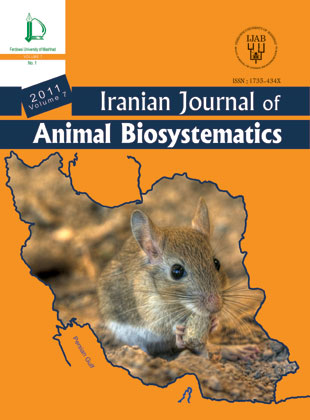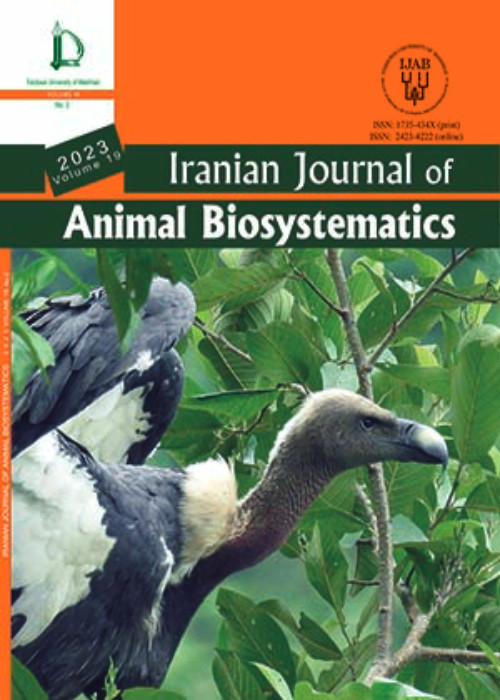فهرست مطالب

Iranian journal of animal biosystematics
Volume:7 Issue: 1, Winter-Spring 2011
- تاریخ انتشار: 1391/05/05
- تعداد عناوین: 6
-
-
Page 1Inter- and intra-population variations of a recently described endemic cyprinid fish Alburnoides qanati Coad and Bogutskaya, 2009 collected from three localities in the Kor River basin, Iran, were studied by applying morphometric and meristic characters using canonical discriminate function analysis (DFA), principal component analysis (PCA) and cluster analysis (CA). In DFA, the overall random assignment of individuals into their populations was 96.6% based on all the adjusted morphometric characters, 94.6% for meristic characters, and 100% based on both morphometric and meristic characters, indicating that the original grouped cases were correctly classified and they belonged to three morphologically distinct populations. The first principal component (PC) accounted for 16% and the second PC accounted for 15.8% of the shape variations among the samples. The Cluster analysis revealed a similar pattern of separation of one population from the others. The morphological heterogeneity observed in this species should be considered in conservation management and stock enhancement programs, especially during drought conditions in the region.Keywords: Alburnoides qanati, inter, intra, population variations, morphological differences
-
Page 13Iran contains 36 named endemic reptile species in 17 genera and seven families. The most endemic and speciose family is the Gekkonidae, followed by the Lacertidae. These two families collectively dominate with 22 species (or 60.1%) of the total endemic herpetofauna. Twenty one endemics are known only from a single location or restricted area within a single physiographic region. An analysis of endemicity is given in terms of systematics and distribution.Keywords: Iran, herpetofauna, endemics, systematics, distribution, type locality
-
Page 31During ornithological expedition to four provinces in the northeast and north of Iran in June 2009, a total of 117 bird species belonging to 14 orders and 40 families were recorded. Based on these records, eight bird species were found outside their presumed breeding range according to the available distribution maps covering Iran, suggesting that updating of the distribution maps should be provided.Keywords: birds, Iran, record, avifauna, distribution
-
Page 50Genus Meriones is the dominant member of gerbils in the Palaearctic region, particularly in aride region of Asia. This is also one of the most typical genus of subfamily Gerbillinae with about 17 morphospecies namely: M. persicus, M. hurrianae, M. zarudnyi M. vinogradovi, M. meridianus, M. libycus, M. crassus, M. tristrami, M. rex, M. tamariscinus, M. unguiculatus, M. shawi, M. grandis, M. sacramenti, M.dahli, M.chengi, M.arimalius. Of which first eight species have been recorded from the Iranian Plateau. There are minor differences between some species and hence, interspecific discrimination of specimens from each species is not always possible, even by polythetic methods using different taxonomic characters such as tympanic bullae, suprameatal triangle and external characters on material from museums and dental characters on archeozoological materials. Here, 26 morphological characters of 384 museum specimens belonging to 14 morphospecies of Meriones from North Africa, Iran and Central Asia were studied. This study review, 14 species of Meriones and based on the results, it seems that M.libycus, M. crassus and M. meridianus are complex species and need taxonomic revision. The cladistics analysis shows that M. vinogradovi could be forming ancestral species of genus Meriones, and west of Caspian Sea could be the center of origin for Meriones. Due to the presence of convergence regarding adaptation of different species of Meriones to similar environment, subgeneric morphological characters may cause homoplasies and paraphyletic subgenera the analysis of morphological character states matrix, using Mix program of Phylip shows different four clades that did not conform to the nominative subgenera and unveil probable homoplasy.Keywords: Meriones species, Morphology, phylogeny
-
Page 75Genus Rattus from the subfamily Murinae has a wide geographical distribution throughout the world. Three species of this genus have been reported in Iran so far. They are Norway or brown rat (Rattus norvegicus), black rat (Rattus rattus), and Himalayan rat (Rattus pyctoris). In order to verify the possibility of using electrophoretic patterns of special proteins, in biosystematic analysis of these species, total proteins of plasma (globulins and albumin) and esterse-1 of nine specimens belonging to three species of Rattus, from five populations were analyzed by native-PAGE (native polyacrylamide gel electrophoresis). Electrophoretic patterns of globulins, albumin, and esterase-1 alleles were different in these species and an unknown species was distinguished by this technique. Also, brown rats from Tehran and Mashhad were discriminated by these methods.Keywords: Iran, genus Rattus, native, PAGE, globulins, albumin, esterase, 1


